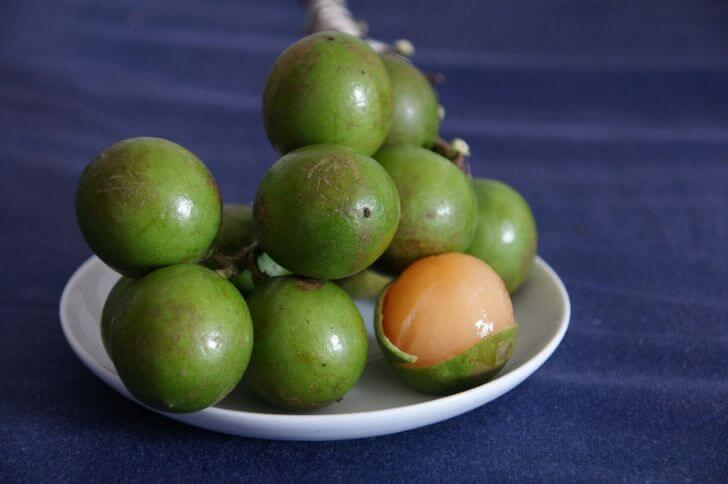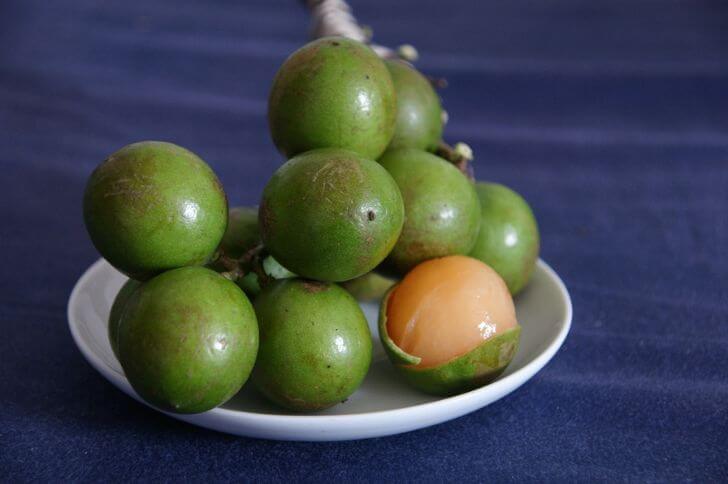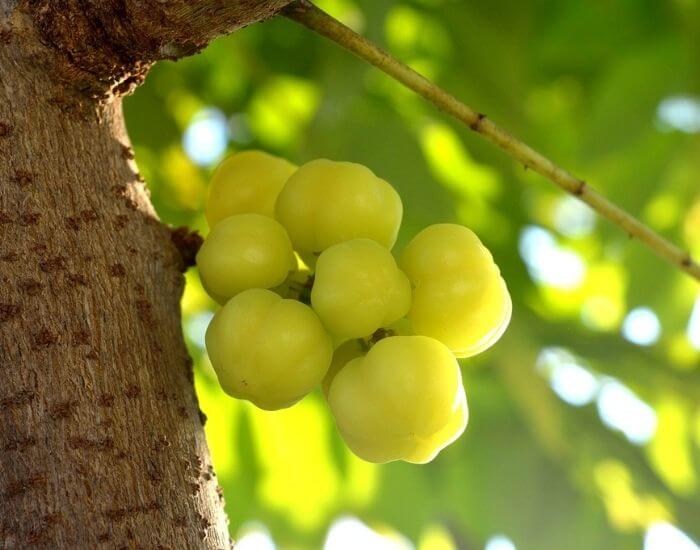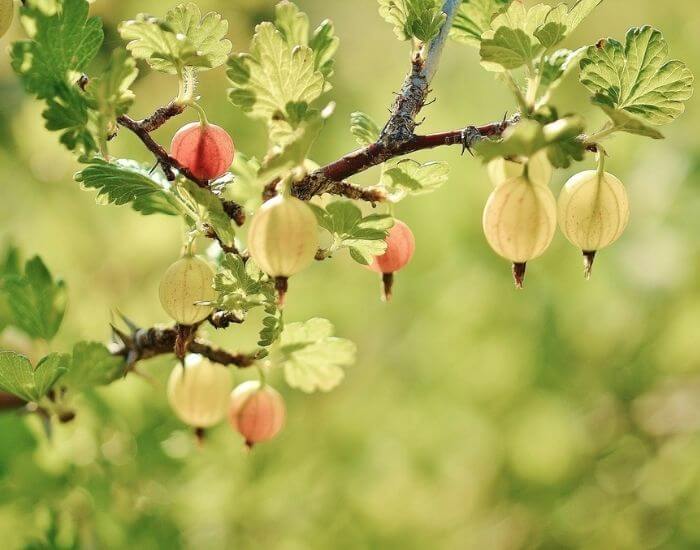The quenepa is a small, round fruit native to the Caribbean and Central America but is now being cultivated in various parts of the world. These small green fruits with a thin outer skin and juicy flesh have been cherished for centuries due to their delightful taste and numerous benefits.
With their tangy-sweet flavor profile reminiscent of a cross between lychee and citrus, quenepas have gained popularity across the globe.
In this article, we will delve into the origins, nutritional value, culinary uses, and more of this fascinating fruit that continues to captivate both locals and curious food enthusiasts alike.
Quenepa other names
Like most fruits, this exotic fruit has other alternative local names. Common names include genip, guinep, mamons, mamoncillo, mamon fruit, chenet, limoncillo, kenep, talapa jacote, quenepe, kenepa and huaya. Quenepas in English are called Spanish limes and are scientifically called Melicoccus bijugatus.
Below we’ll use quenepa or spanish limes or mamones.
Where do quenepas grow
Where do mamones come from? Quenepa originates from the tropical regions of Central America and the Caribbean.
This small green fruit grows in clusters on trees that can reach up to 80 feet in height. Quenepas are primarily grown in countries such as Puerto Rico, Dominican Republic, Colombia, and Venezuela. The fruit thrives in warm climates with high humidity.
The tree is highly adaptable and can grow in various soil types, although it prefers well-drained sandy or loamy soils. It requires ample sunlight for optimal growth and typically starts bearing fruits within three to five years of planting.
Quenepas season
During the quenepas season, which typically falls between June and August, fruit enthusiasts eagerly await the arrival of these small green orbs.
Florida quenepas are available from June to September.
This limited-time availability makes Spanish limes highly sought after in markets where they are imported. Many people look forward to indulging in this delicious fruit during its short but delightful season, whether it’s enjoying them fresh on their own or incorporating them into various culinary creations.
Color

What color are Spanish limes? When it comes to their color, these tiny fruits pack a surprising visual punch. Quenepas typically have a vibrant green hue that ranges from light lime green to a deeper shade of emerald. The color intensity may vary depending on the fruit’s ripeness and growing conditions.
Another distinctive feature of mamones is their smooth skin which adds an extra touch of elegance to their appearance. Despite being called limes, these little fruits are not related to traditional citrus limes but belong to the soapberry family instead.
How to tell if quenepa fruit is ripe
When it comes to enjoying this delicious fruit, knowing how to determine its ripeness is essential. One way to tell if a mamon fruit is ripe is by looking at its color. A ripe quenepa will have a green-yellowish skin with no signs of greenness.
Another method of checking for ripeness is by gently squeezing the fruit. If it feels soft when you apply slight pressure with your fingers, then it’s likely ripe and ready to eat. Additionally, a fully ripe quenepa will have a sweet and slightly tangy aroma that is quite distinct.
The flesh is soft and succulent, with a texture similar to that of a grape. Each fruit contains one large seed surrounded by the juicy pulp that ranges in color from pale yellow to translucent orange.
How to prepare Spanish limes
To prepare quenepas for eating, start by washing them. Next, hold the fruit firmly between your fingers and gently squeeze it until you feel the skin give way slightly. Using your fingernail or a small knife, make an incision in the skin and peel it back to reveal the juicy flesh inside.
Once you have peeled the quenepa fruit, you can simply pop it into your mouth and enjoy its refreshing flavor. However, if you prefer not to eat it whole, there are other ways to savor this tropical treat.
Nutrition
Despite their small size, these tropical treats pack a punch when it comes to nutritional value. Packed with essential vitamins and minerals, mamones are a great addition to any diet.
One of the standout nutrients is vitamin C. Just one serving of these little fruits contains over 100% of your daily recommended intake.
In addition to vitamin C, Spanish limes are rich in potassium and calcium.
Taste
One bite into a ripe quenepa can provide an explosion of tastes on your palate. The initial burst is typically tart and citrusy, awakening your taste buds with its refreshing acidity.
As you continue to chew the fruit, the tanginess gradually gives way to a subtle sweetness that balances out the overall flavor experience. This delightful blend of contrasting tastes makes quenepa an exciting tropical treat for those seeking something different from traditional fruits.
The specific taste notes of quenepa can vary depending on factors such as ripeness and growing conditions.
Some may find it more acidic or sour than others, while some fruits may have an extra touch of sweetness. Nevertheless, no matter how you describe it, there’s no denying that quenepa provides a unique sensory experience for fruit enthusiasts looking for new flavors to explore.
How to eat quenepas
There are several delicious and creative ways to enjoy quenepa fruit. One popular method is to simply peel off the skin and pop into your mouth, sucking on it to extract the juicy pulp while discarding the large seed.
Guinep chow
Ingredients:
- 30 ripe quenepas
- 1 hot pepper (such as scotch bonnet)
- 3 or 4 grated garlic cloves
- Juice of 1 lime
- 4 beni leaves
- Salt to taste
Steps:
- Peel quenepas
- Blend beni and garlic hot pepper
- In a bowl, combine the quenepa, garlic, hot pepper, lime juice, and salt.
- Let the chow sit for at least 15 minutes to allow flavors to meld together.
- Serve and enjoy!
Quenepa Juice
One delicious way to enjoy quenepa fruit is by making a refreshing quenepa juice. Start by peeling the outer skin of the fruit to reveal the juicy flesh inside.
Remove the seeds and place the fruit in a blender along with some water and a sweetener of your choice, such agave syrup. Blend until smooth, then strain the mixture to get rid of any remaining pulp. Serve chilled over ice for a delightful and thirst-quenching beverage.
Related Read: Learn about Uchuva fruits
Storage:
How do you store mamones fruit? Storing quenepa fruit properly is essential to maintain its freshness and flavor.
After purchasing or harvesting the fruit, it is important to sort through them and discard any damaged or overripe ones.
They should be stored at room temperature for a few days until they fully ripen, as refrigeration can hinder the ripening process.
You can also refrigerate quenepas. Properly stored mamon fruit can last up to two weeks in the refrigerator.
An alternative storage method for quenepa fruit is freezing. First, wash. Then, remove their outer shell by carefully cracking it with a knife without damaging the inner flesh.
Once peeled, place them on a baking sheet lined with parchment paper and freeze them until firm. Transfer the frozen quenepas into an airtight container or freezer bags for long-term storage in the freezer – they will retain their flavor for up to six months when frozen properly.
Quenepas near me
If you’re wondering where to buy quenepas, good news! This tropical fruit is becoming more readily available in various places. One of the easiest ways to find them is at your local farmers market.
Many vendors specialize in rare and exotic fruits, and they often have quenepas when they are in season. Additionally, if you live in a region with a large Latin American or Caribbean population, it’s likely that you can find fresh quenepas at specialty stores catering to these communities.
Another option for purchasing quenepas is online. There are online retailers that source their products from all around the world, making it possible for you to easily order quenepas regardless of your location.
Just make sure to do some research on the website’s reputation and shipping policies before placing an order.
Is quenepa fruit same as lychee?
While it may share some similarities with the lychee fruit, they are not the same. Quenepa has a greenish-yellow outer skin that is smooth and thin, while lychee has a rougher textured reddish-brown outer skin.
When it comes to taste, quenepa has a unique flavor profile that can be described as a combination of citrusy and sweet with hints of sourness, whereas lychee has a distinct floral sweetness.
Also the spanish lime has yellow-orange flesh while the lychee has white flesh.
Are quenepas Puerto Rican or Dominican?
Spanish limes are popular in both Puerto Rico and the Dominican Republic. However, the debate over their origin has sparked discussions among locals.
Some argue that quenepas are more closely associated with Puerto Rican cuisine due to their long history of cultivation on the island. They are often enjoyed as a refreshing snack or used in various culinary dishes and beverages.
On the other hand, others claim that quenepas have stronger connections to Dominican culture. In the Dominican Republic, these small green fruits are widely consumed and loved for their sweet and tangy flavor.
Many households have quenepa trees in their backyards, making them easily accessible throughout the country.
Despite this ongoing dispute between Puerto Rico and the Dominican Republic, it is important to note that both countries share a rich cultural heritage deeply rooted in agriculture.
Quenepas serve as a symbol of this shared tradition, bridging gaps between two nations through its unique taste and versatility in regional cuisines.
What are quenepas called in Mexico?
In Mexico, quenepas are known by various names depending on the region. In some parts of the country, they are called mamoncillos, while in other areas they may be referred to as limoncillos or huaya.
These small green fruits are highly popular in Mexico and can often be found sold by street vendors or at local markets.
No matter what they are called, one thing remains consistent – quenepas are loved for their unique taste and textural experience in Mexico. So, if you happen to come across these fruits while visiting this vibrant country, be sure to give them a try!
Can you eat quenepa seeds?
The seeds of quenepa are typically large and hard, making them difficult to chew and digest. Some people choose to spit out the seeds while enjoying the fruit’s flesh, as they can be quite bitter in flavor. However, others choose to consume them.
Will quenepas grow in Florida?
Quenepas prefer warm temperatures and high humidity, which makes Florida an ideal candidate for their cultivation. Additionally, the state’s sandy soil provides good drainage for these trees.
Quenepas or limoncillo?
Both names describe the same fruit. Quenepa is the local name for Spanish limes in Puerto Rico while limoncillo is the name used in the Carribeans.
Hi There,
My name is Jenny. I’m the Chief Editor at Try Green Recipes and besides making yummy and healthy foods for my kids, grandkids, and friends. I’m new to the blogging world but I believe what I have to share is unique and will bring joy to your home. If you are adventurous and want try something tasty, let’s get started.


